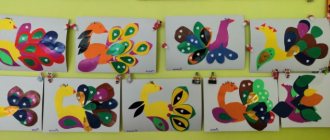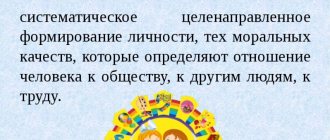Artistic and aesthetic education of preschool children
Already at preschool age, children are able to respond to the beautiful in their surroundings, music, poetry, objects of fine art, nature, and they themselves strive to draw, sculpt, sing, dance, and write poetry. Adults and children are constantly exposed to artistic and aesthetic phenomena. In the sphere of spiritual life, everyday work, communication with art and nature, in everyday life, in interpersonal communication - everywhere the beautiful and the ugly, the tragic and the comic play a significant role. Beauty brings pleasure and pleasure, stimulates work activity, and makes meeting people pleasant. The ugly is repulsive. The tragic teaches empathy. Comic helps to fight shortcomings. Aesthetic education is a purposeful, systematic process of influencing a child’s personality in order to develop his ability to see the beauty of the surrounding world, art and create it. It starts from the first years of children's lives.
Aesthetic education is a very broad concept. It includes the education of an aesthetic attitude towards nature, work, social life, everyday life, and art. However, the knowledge of art is so multifaceted and unique that it stands out from the general system of aesthetic education as a special part of it. Raising children through art is the subject of artistic education.
In turn, aesthetic education is part of the comprehensive communist education of children. Its connection with moral education is especially close. Beauty is perceived by a child as a unity of form and content. Form is expressed in a combination of sounds, colors, lines. However, perception becomes aesthetic only when it is emotionally colored and associated with a certain attitude towards it.
Aesthetic perception is inextricably linked with feelings and experiences. A feature of aesthetic feelings is disinterested joy, a bright emotional excitement that arises from meeting the beautiful.
Acquaintance with beauty in life and art not only educates the child’s mind and feelings, but also contributes to the development of imagination and fantasy. Aesthetic education is the most important aspect of raising a child. It contributes to the enrichment of sensory experience, the emotional sphere of the individual, affects the knowledge of the moral side of reality, increases cognitive activity, and even affects physical development. The result of aesthetic education is aesthetic development. The formation of children’s aesthetic attitude to the world around them is influenced by the development of the ability to see and feel beauty in nature, actions, art, and to understand beauty. You should also cultivate artistic taste, the need for knowledge of beauty. The tasks of preschool education are also aimed at developing artistic skills in the field of various arts: teaching children to draw, sculpt, design, sing, move to music, and develop verbal creativity. Aesthetic education of children is carried out by familiarizing children with the aesthetics of everyday life, with the beauty in work, in nature, social phenomena, and the means of art. Teaching a child to feel and understand the beauty of life is a big and difficult task that requires long-term work by adults. Certain conditions are necessary for the aesthetic education of children. First of all, this is the environment in which he lives and develops. These are the things around him, the appearance of people, and the beautiful relationships between people. But it is not enough for children to see the beauty around them in its various manifestations, but it is also worth drawing their attention to this beauty.
“Artistic education is a process of purposeful influence by means of art on a person, thanks to which those educated develop artistic feelings and taste, love for art, the ability to understand it, enjoy it and the ability to create in art if possible” [V. N. Shatskaya, 1987, 35]. Aesthetic education is much broader; it affects both artistic creativity and the aesthetics of everyday life, behavior, work, and relationships. Aesthetic education shapes a person with all aesthetically significant objects and phenomena, including art as its most powerful means. Aesthetic education, using artistic education for its purposes, develops a person mainly not for art, but for his active aesthetic life.
In the book “The Child in the World of Creativity”, edited by N. Varkka, one can find the following formulation: “Pedagogy defines the artistic and aesthetic education of preschool children as a purposeful process of forming a creatively active personality of a child, capable of perceiving and appreciating the beauty in life and art” [N. Varkki, 2003, 53].
So, artistic and aesthetic education has an active and creative orientation, which should not be limited only to a contemplative task, it should also form the ability to create beauty in art and life. Communicating with the aesthetic phenomena of life and art, the child, one way or another, develops aesthetically and artistically. But at the same time, the child is not aware of the aesthetic essence of objects, and development is often determined by the desire for entertainment, and without outside intervention the child may develop incorrect ideas about life, values, and ideals.
The main thing is to educate and develop such qualities, such abilities that will allow the individual not only to achieve success in any activity, but also to be the creator of aesthetic values, to enjoy them and the beauty of the surrounding reality. In addition to the formation of children’s artistic and aesthetic attitude to reality and art, artistic and aesthetic education simultaneously contributes to their comprehensive development. It contributes to the formation of a person’s morality, expands his knowledge about the world, society and nature. A variety of creative activities for children contribute to the development of their thinking and imagination, will, perseverance, organization, and discipline.
Most researchers distinguish the following categories: aesthetic perception, aesthetic taste, aesthetic ideal, aesthetic assessment. D. B. Likhachev also distinguishes aesthetic feeling, aesthetic need and aesthetic judgment [D. B. Likhachev, 1996, 42]. We mentioned categories such as aesthetic appreciation, judgment, and experience earlier. Along with them, the most important element of aesthetic consciousness is aesthetic perception.
Perception is the initial stage of communication with the art and beauty of reality. All subsequent aesthetic experiences and the formation of artistic and aesthetic ideals and tastes depend on its completeness, brightness, and depth. D. B. Likhachev characterizes aesthetic perception as: “a person’s ability to isolate processes, properties, qualities that awaken aesthetic feelings in the phenomena of reality and art” [D. B. Likhachev, 1996, 45]. This is the only way to fully master an aesthetic phenomenon, its content and form. This requires the child to develop the ability to finely distinguish shape, color, evaluate composition, ear for music, distinguish tonality, shades of sound and other features of the emotional and sensory sphere. The development of a culture of perception is the beginning of an artistic and aesthetic attitude towards the world.
Aesthetic phenomena of reality and art, deeply perceived by people, are capable of generating a rich emotional response. The emotional response, according to D. B. Likhachev, is the basis of artistic and aesthetic feeling. It is “a socially determined subjective emotional experience, born of a person’s evaluative attitude towards an aesthetic phenomenon or object” [D. B. Likhachev, 1996, 53]. Depending on the content and brightness, aesthetic phenomena can arouse in a person feelings of spiritual pleasure or disgust, sublime experiences or horror, fear or laughter. D. B. Likhachev notes that by experiencing such emotions repeatedly, an aesthetic need is formed in a person, which is “a persistent need to communicate with artistic and aesthetic values that evoke deep emotions” [D. B. Likhachev, 1996, 48].
Another category of artistic and aesthetic education is complex socio-psychological education - aesthetic taste. Yu. B. Borev defines it as “a relatively stable personality property, which enshrines norms and preferences that serve as a personal criterion for the aesthetic assessment of objects or phenomena” [Yu. B. Borev, 1988, 92]. D. B. Nemensky defines aesthetic taste as “immunity to artistic surrogates” and “thirst for communication with genuine art.” But we are more impressed by the definition given by E. O. Gusev. “Aesthetic taste is the ability to directly, by impression, without much analysis, feel and distinguish what is truly beautiful, the true aesthetic merits of natural phenomena, social life and art” [E. O. Gusev, 1978, 37].
Aesthetic taste is formed in a person over many years, during the period of personality formation. At preschool age there is no need to talk about it. However, this in no way means that aesthetic tastes should not be cultivated in preschool age. On the contrary, aesthetic information in childhood serves as the basis for a person’s future taste. The child has the opportunity to systematically become acquainted with the phenomena of art. It is not difficult for the teacher to focus the child’s attention on the aesthetic qualities of the phenomena of life and art. Thus, the child gradually develops a set of ideas that characterize his personal preferences and sympathies.
The entire system of artistic and aesthetic education is aimed at the overall development of the child, both aesthetically and artistically, as well as spiritually, morally and intellectually. This is achieved by solving the following tasks: the child mastering the knowledge of artistic and aesthetic culture, developing the ability for artistic and aesthetic creativity and the development of aesthetic psychological qualities of a person, which are expressed by aesthetic perception, feeling, evaluation, taste and other mental categories of aesthetic education.
Literature:
1. Azarov Yu. P. The art of education. M.: Education, 1985.-127p.
2. Alekseev P. G. Methodological principles of designing educational systems / P. G. Alekseev // Design in education: Problems, searches, solutions. - M.: Vlados, 1994.-98 p.
3. Alekseeva M. M., Yashina V. I. Speech development of a preschooler. M., 1998.-242 p.
4. Amonashvili Sh. A. Reflections on humane pedagogy. M., 1996
5. Varkki N. A child in the world of creativity: Creative and aesthetic education of preschool children / N. Varkki // Preschool education. - 2003. - No. 6. - P.57–67.
6. Borev Yu. B. Aesthetics. M.: Publishing house of political literature, 1988.-178 p.
7. Borev Yu. B. Aesthetics. M.: Rus-Olympus: AST: Astrel, 2005.-829 p.
8. Vygotsky L. S. Selected psychological studies. M., 1980.-384 p.
9. Vygotsky L. S. On the issue of multilingualism in childhood // Reader on age and pedagogical psychology. M., 1996.
10. Vygotsky L. S. Thinking and speech / Ed. G. N. Shelogurova. M.: Labyrinth, 1996.
11. Vygotsky L. S. Imagination and creativity in childhood. - M.: Pedagogy, 1991.
12. Grigorovich L. A. Development of creative imagination. - M., 1997.-175 p.
13. Gusev E. O. Creative process and artistic perception. L., 1978.-94p.
14. Likhachev B. T. Methodological foundations of pedagogy / B. T. Likhachev. - Samara: Bakhrakh, 1998.
15. Likhachev D. B. Theory of aesthetic education of schoolchildren.
16. Ushinsky K. D. Selected pedagogical works. M., 1974.-p.287
17. Fokina T. Program for the artistic and aesthetic development of preschoolers / T. Fokina // Preschool education. - 1999.-No. 1.-p.35–38.
18. Artistic creativity and the child / Ed. N. A. Vetlugina. - M.: Pedagogy, 1992.
19. Shatskaya V.N. General issues of aesthetic education at school, 1987.-184p.
20. Aesthetic education in kindergarten: A manual for kindergarten teachers / Ed. N. A. Vetlugina. - M.: Education, 1995.
The place of aesthetic culture of education in society
Aesthetic culture is one of the elements of public culture, one of its oldest forms, which arose in the era of primitive man. Only over time did it acquire a somewhat independent meaning, but even now it appears in the form of a kind of philosophy, reflecting a person’s rich attitude to the world, his desire for perfection and ideal.
Since ancient times, the idea of beauty has been interpreted quite broadly: health, wealth, and everything that was useful were considered beautiful. Beauty was considered not only from the point of view of aesthetics, but also ethics, economics, and a perfect object or state was recognized as beautiful.
In our society, there is a clearly visible gap between the social significance of aesthetic culture and its real state. Traditional cultural and moral values are replaced by rational and logical ones, which leads to a lack of emotionality in relationships, rudeness and cynicism, and a primitivization of life guidelines.
Depending on a specific era of life, ideas about beauty may change. The concept of beauty is rather inherent in external form. The beautiful does not depend on time and carries within itself harmony, perfection, and humanistic spiritual components.
The modern busy, overpopulated world is educationally untenable. It produces only educated consumers, and the principle of aesthetic education presupposes the creation of conditions for development, the creative disclosure of each individuality.






